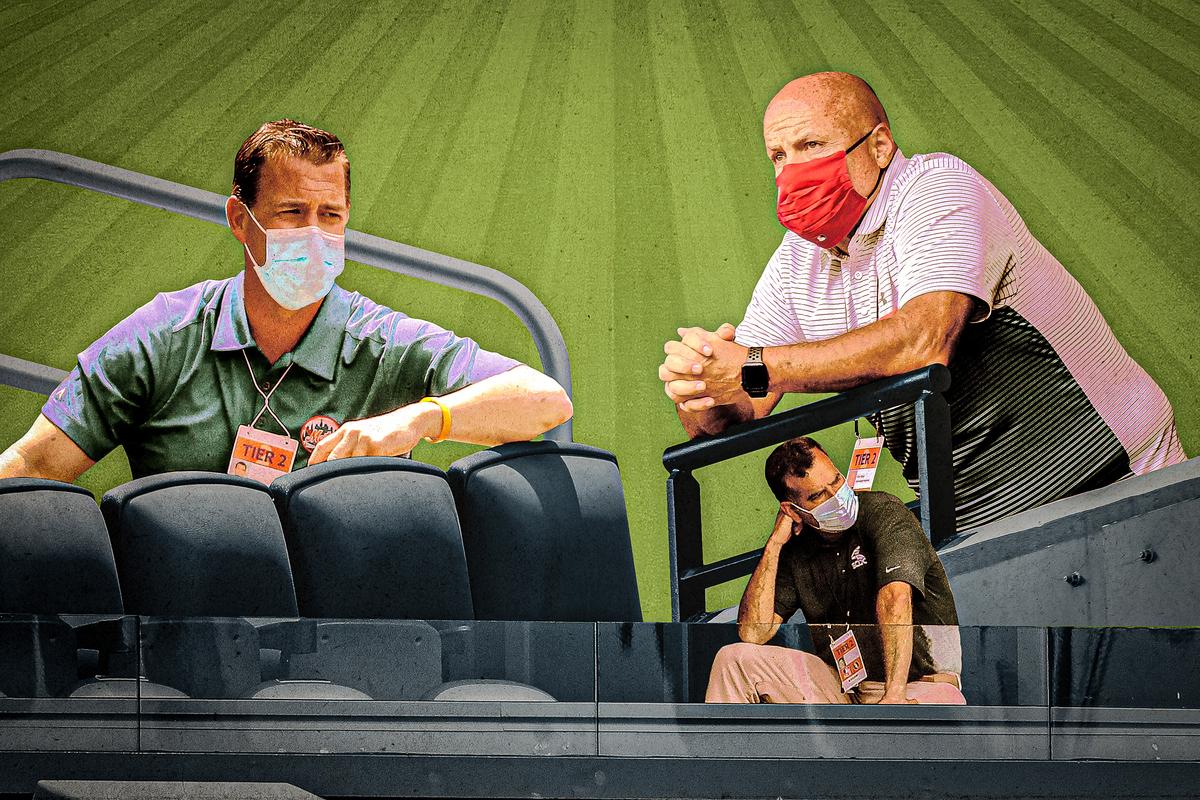
The MLB trade deadline is less than a week away, on August 31, which is quite a sentence to type considering one team still hasn’t reached the 20-game mark. The strangeness of the 2020 season extends to the trade space, too; the most notable player to exchange teams so far this month is Brandon Workman, a former Boston reliever who has a 3.43 WHIP—that’s WHIP, not ERA—since moving to the Phillies.
While it’s still possible that a true difference-maker like Mike Clevinger is traded, after the Cleveland pitcher ran afoul of his clubhouse when he lied about breaking curfew, any blockbuster at this point would register as a surprise. Here are the complicating factors, all a result of this season’s unprecedented structure and schedule, that could combine to dim the impact of the 2020 trade deadline.
1. Small Sample Statistics
In a typical season, contending teams have time to track their trade targets, and then assess their skill and fit on the club. Franmil Reyes already had amassed 354 plate appearances and blasted 27 home runs for San Diego before joining Cleveland last July; Zack Greinke already had made 23 starts and thrown 146 innings for Arizona when he was shipped to Houston on deadline day. Even relievers like Mark Melancon, Shane Greene, and Chris Martin had thrown an average of 41 innings with their previous teams before joining Atlanta.
Teams don’t have that luxury this season. Trevor Rosenthal has impressed in Kansas City’s bullpen after battling Hulkish control problems in 2019, and he could help a bullpen in need; he’s also impressed over just 11 1/3 innings. More granular, process-based data like velocity and spin rate can theoretically help a front office make judgments in smaller samples than results-oriented stats, but there’s still a limit to how much they can trust small sample information. And that extra level of uncertainty might make them less prone to push for a deal.
2. The Expanded Playoff Bracket
The 16-team postseason format complicates most buy/sell decisions, particularly in a shortened season with less time for teams to separate themselves in the standings. With a lowered barrier for entry, more clubs stay in the race, and thus fewer clubs have incentive to punt on this season and look toward the future.
In the National League as of Tuesday morning, the Pirates are the only team more than 1.5 games out of a playoff spot. Why would any non-Pittsburgh club trade away key pieces when they’re so close to a playoff spot, and thus a shot at the title? The Reds, for instance, are 11-16 and in 14th place in the NL standings, and they could trade Trevor Bauer, who is a free agent after this season and boasts the league’s top strikeout rate. But if they keep Bauer and sneak into the playoffs, a postseason rotation with Bauer, Luis Castillo, and Sonny Gray—all currently ranked in the top 10 in the majors in fWAR—could spark any upset, especially in a best-of-three first round.
The American League paints a different postseason picture. More AL clubs are essentially out of the playoff picture, with the Royals, Mariners, Red Sox, and Angels all at least four games back. But the junior circuit has a different trading dilemma: As of Tuesday morning, FanGraphs gave seven different AL teams at least a 96 percent chance of making the playoffs. The hardest part of winning the World Series is making the playoffs in the first place—after that, especially in a weird year with less home-field advantage and a short first round, anything can happen—so all the top AL teams have less urgency to improve, especially because of reason no. 3.
3. Uncertainty Around This Year’s Playoffs
Even if, say, the Giants were willing to trade pending free agent Kevin Gausman—itself a question, because the Giants are currently in a playoff position—potential buyers might be more resistant than usual to part with prospects for a rental. What if the season never finishes, due to COVID-19 cancellations? Then those teams would lose prospects for no benefit.
The playoffs are due to start in just more than a month, and MLB still doesn’t know what they will look like. Will MLB adopt one bubble? Two? More? Will travel around the country, to each team’s home ballpark, continue? Front offices debating trade decisions can’t just consider the present versus the future, or the chance that a new player is better than the man he’d replace. They also have to consider how comfortable they feel that the 2020 postseason will happen at all.
4. Uncertainty Around Future Finances
One trade idea that naturally pairs player and team need is Kyle Seager to Atlanta; the veteran Seattle third baseman is hitting .291/.377/.515 this year, versus the combined .195/.244/.372 line put forth by Atlanta’s third basemen (a near-even mix of Austin Riley and Johan Camargo). Atlanta leads its division but ranks 29th in third-base WAR. Seager would solve that problem.
But he’s also owed $18 million next season, and if he’s traded, a $15 million club option for 2022 will convert to a player option, putting Atlanta potentially on the hook for $33 million extra in future payments beyond this year. Without knowing how the ongoing pandemic will affect attendance—and thus team revenue—next season, teams might be more reluctant than normal to add hefty financial commitments.
The same thought process applies to J.D. Martinez, who ranked second to Mike Trout in wRC+ over the past half-decade (minimum 2,000 plate appearances). The Boston DH is struggling so far this season (.228/.322/.406 slash line) but presumably hasn’t forgotten how to hit, and the moribund Red Sox would surely like to flip Martinez for prospects. But as long as Martinez doesn’t opt out of his contract after this season, he’s owed a shade under $20 million in both 2021 and 2022. Maybe, in a normal season, prospective buyers would look past Martinez’s slump to try to add his bat to their lineup; in this particular season, they’re exceedingly unlikely to look past his slump and commit to an extra payment in the mid-eight figures when the league’s financial landscape remains so hazy.
5. Uncertainty Around Future Roster Rules
Speaking of Martinez, a lesser but still relevant complication is the league’s shifting rule book. For the first time, in response to the pandemic, the National League is using the designated hitter, which doubles the number of teams that can justify playing Martinez, who should be DH-only for a contending team. But if the league reverts to a pitcher-batting rule after this season, players like Martinez would become much less valuable to those same NL clubs overnight. So even if they were willing to ignore the financial implications of adding his contract, they probably wouldn’t want to risk rostering him without a lineup spot guaranteed past this season.
6. Roster Restrictions in Trades
The next item on the list concerns the very logistics of trades in 2020. Because of this season’s unique roster rules, only players in each team’s 60-man player pool can be traded—which means no long-shot minor leaguers, no Low-A prospects, no reclamation projects if they’re not currently on the team’s big league roster or at its alternate site. Thus the pool of prospects available in trade shrinks from hundreds per team to just a couple of dozen.
In some cases, clubs could get around that obstacle by trading established big leaguers for “players to be named later,” and then formally completing those trades in a few months, when the 60-man limit lifts. But even that loophole doesn’t solve the next, fundamental problem with trading for prospects in a season like this.
7. A Lack of Prospect Data
Deadline trades are not zero-sum actions; they’re usually win-win (or, in three-team deals, win-win-win), as teams exchange present for future value, and vice versa, depending on their planned contending timelines. For the future-oriented teams, that means knowing which prospects to target in trades—which means that not knowing how those young, volatile players have developed over the past year is a rather significant problem.
MLB is trying to address the issue; ESPN’s Kiley McDaniel reported that teams can opt in to a data- and video-sharing arrangement from alternate sites, where the players in the 60-man pool but not on the active roster are working out. “It’s a simple setup: submit whatever video and TrackMan data you’ve been recording to MLB, and you’ll get what’s been submitted by other clubs that opted in,” McDaniel wrote. “Out of contention and want to trade a big leaguer for a top prospect? Now you know what they’ve looked like for the last handful of weeks.”
But this solution falls short in some areas. The prospects at alternate sites aren’t playing in real games with real statistics, so it will be difficult to determine how much credence to give, say, exit velocity readings in surreal conditions. Most lower-level prospects aren’t at the alternate sites at all, and thus have no data to share. Injury information could be a black box.
Even the “player to be named later” approach might not help much here, if player development information remains murky through the fall and winter. It’s hard to imagine, say, the Rangers trading ace Lance Lynn if everything they know about the top prospects they’d target in return is a year out of date.
8. Player Opt-Out Possibilities
Every obstacle on this list stems at least in part from the coronavirus, and the last is no exception. With any player able to opt out of the season if he forgoes his remaining 2020 salary and service time, potential trade candidates all can wield an effective no-trade clause if they choose, by threatening to opt out if they’re sent to an undesirable location. If a player might be shipped to the second-place Marlins, who are reportedly planning to upgrade their bullpen in advance of a potential playoff run, he could try to squash the deal by saying he wouldn’t play in Miami.
That theoretical pressure might not arise; as ESPN’s Jeff Passan notes, “almost every major league player traded is going from a bad team to a good one. That’s usually enough incentive and motivation for a player to keep playing.” But given the swirling demands of family and safety and personal comfort in this most uncomfortable baseball environment, it’s at least a possibility. There are already enough forces working against an active deadline weekend, and this overarching threat is just another pushing in the same direction.
Stats through Monday’s games.

